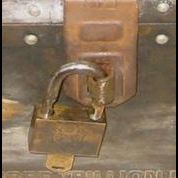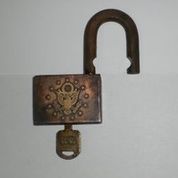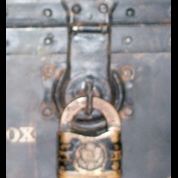USA 1934 Series Bonds
Going back 27 years ago I saw my first 1934 Series Bonds – Federal Reserve Note Coupon Bond. I was told the story of how these bonds were part of a secret cache of bonds from WWII. The bonds were used by the US to coax (read: buy off) Chang Kai-Shek in the late 1930 and 1940s to get him to actually fight the Japanese, and later the communists. The bonds were created by some enterprising OSS Officers in China to in effect bribe a foreign official, the General of the Kuomintang (founded by Sun Yat Sen in 1912) to do what he was supposed to do in the first place. In a short history lesson, Chang Kai-Shek hid the weapons because he was more afraid that the public would use the weapons to turn on him. Chang Kai-Shek’s apprehension was correct and he fled to Taiwan in 1949 with cash and most of the national treasury of China. But for some reason the bonds were left behind in China and stored in a climate-controlled cave. These were exchanged with the Kuomintang for their gold so the Japanese couldn’t obtain it. The bonds were backed by all of the gold in the US treasury and now the Chinese want was purported to be their gold back!
Another 1934 bond origin tale goes back to 1871, involving two Freemasons who conspired to start two world wars and to force all of the nations to exchange their gold for these bonds that were essentially safekeeping receipts for the gold. After WWI the Treaty of Versailles was set up to help rebuild the world and the BIS (Bank for International Settlements) was created by the founders of the Federal Reserve. All the gold in Europe—and, it appears, everywhere else—went to the US Government in exchange for these Series 1934 safe keeping receipts / bonds. It is rumored that 8 ships departed China for the US with gold so it could not be by looted by the Japanese occupiers. In 1998 the 60 year hold ended, the boxes were dug up, and the people who originally gave their gold for paper wanted it back. The US said no such exchange occurred. Later, in a secret court in the Hague, the US lost the litigation of the claim and was ordered to turn over the gold by September 11, 2001. The US did not turn over the gold and the Twin Towers were attacked, accompanied by a mysterious collapse of the World Trade Center number 7. Few knew the gold vaults were under building number 7, and fewer knew they were discovered to be empty after the collapsed structure was excavated down to the vault levels. No doubt this was the heist of the century.
Details aside, most stories agree each “Mother Box” contains 13 cases and a Treaty Of Versailles scroll describing how to redeem the bonds. 12 of the cases contain the bonds. Why twelve cases? There are 12 Federal Reserve Districts and Banks. The 13th case contains all of the safe transit and authentication papers. The bonds are variously reported to have been found at plane crash sites in the Philippians, climate controlled caves run by the Dragon Family (Asia Secret Society) or heirs of the Plum Blossom Family (allegedly the true owners of the gold deposits covered by the said bonds), or even found in the vaults of Swiss Cantonal Banks when the banks were forced to repatriate booty from WWII in the 1980’s. All excellent tale one can amuse oneself with but just searching for them on the web.
The Investigation
In any investigation, one needs to rely on a team of experts in different areas. I have leaned on the expertise of professionals who are familiar with locks, collectors of antique chests, printing experts and those who are experts in the history of the Federal Reserve Bank and its relationship with the US Government and US Treasury. In the analysis of this apparent fraud let’s begin with the outside and work our way in toward the cases and the bonds.
The Mother Boxes
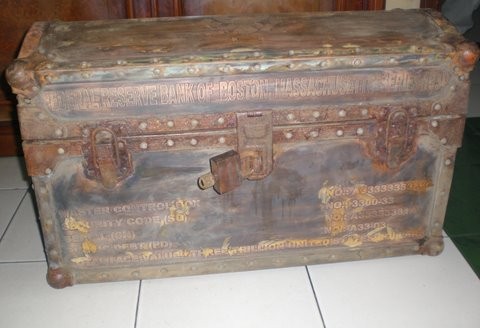
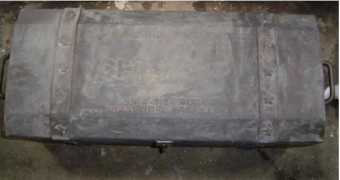
FRB- Chicago
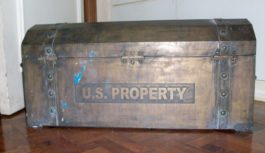
FRB- Boston
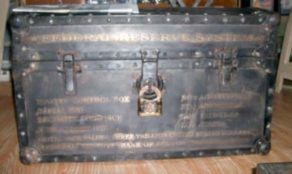
covered in metal
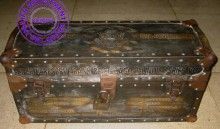
FRB Chicago with BS recovery team logo on the photo
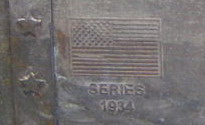
with 50 stars on it
It should be noted that the design of each of the five different trunks is not only different but so are their sizes, the material and the choice of Federal Reserve Bank, even though a few purport to be from the same Federal Reserve Bank. I might also add that since Hawaii and Alaska did not come into the Union until 1959 the US flag from 1934 with 50 starts for 50 states would be incorrect by at least 16 years. It is also important to note that this is not an error that could have reasonably been made by a US Citizen in 1934 or even as US based modern forger. I also want to add that the metal box, designed as a strong box, looks to be functionally, for the tall tale purposes, a smarter choice, whereas the others are merely modified trunks.
Trunks 1 and 5 are nearly identical. According to those who know about trunks, they look to be United Stets Navy Footlockers with the original locking circular hasp replaced with an eyelet hasp. The service men replaced most all of the circular hasps, as they were so easily picked open. Trunk 4 is a later period (1940s to 1950s) trunk most commonly used by children being sent off to school. It is also interesting to note that some of the trunk hardware for the corners was designed in the 1970’s. Trunks 2 and 3 look similar but are cursed with the 50 star flag and a 1934 “Series” issue. Also, the US government, including—the military services—only used flat top trunks. The rounded top was a design feature meant to be attractive to retailer buyers to get more buyers for a given line of trunks. While aesthetically pleasing, rounded top trunks stack poorly and were thus often tipped on their side when stowed. For sake of storage, the Federal Government has wisely never been a purchaser of rounded top chests, footlockers or Mother Boxes.
The Padlocks
The padlocks themselves have some inconsistencies. Each lock is different in style and design. One is very plain and the other two, while embellished, are engraved differently and are different types of locks. The locks center and left appear to be of a mid 1930’s brass model that when a cam inside is turned with the action of the key forces two ball bearings out and into the notches of the shackles. This ball bearing lock mechanism for the shackle was a new innovation at the time and helped to make the locks more resistant to tampering and lock failures from pulling or yanking. The lock on the right is an old Yale and Towne lock that was an older hinge type lock, and not as resistant to tampering. However, all three appear to be date-appropriate genuine military issued locks, according to the experts. The military issued locks had brass bodies and shackles so they were both resistant to corrosion, and if the need arose the lock was easily cut and removed so an official could gain immediate access to the contents of the locked item, be it a footlocker or personal cabinet. These locks would be the antithesis of a secure lock. These locks do not even resemble high security locks of time period of 1930 to 1940 that one would think one should use when securing billions or trillions of dollars in bonds.
The Federal Reserve and US Treasury
The Federal Reserve System is a system set up by the US government in 1913. It is composed of 12 independent Federal Reserve Banks that are owned by banks in those different Federal Reserve Districts. In short the Federal Reserve Banks are owned by the member banks. It is also a quasi-Federal Institution in that its policy and direction are set by the Federal Government, although employees of the Federal Reserve Bank are not federal employees. And while not operated as a for profit venture, the Federal Reserve Banks have provided profitable returns to both their shareholders and the Federal Government. All sums earned and not paid out to shareholders on their mandatory 6% annual dividend are turned over to the US Treasury. So the Federal Reserve is a company not chartered for but yet delivers profit, has shares that do not really convey full ownership because of the Federal Government’s oversight, and is our central banker in charge of many parts of the economy such as monitory policy, reserves and the issuance of currency—but not debt. The Federal Reserve may be the mother of all Special Purpose Vehicles, but it nonetheless is not responsible for issuing debt.
The US Treasury is the older of the two and dates from 1789. The role of the US treasury is to manage the finances of the US. Its official mission is to “serve the American people and strengthen national security by managing the U.S. government’s finances effectively, promoting economic growth and stability and ensuring the safety, soundness and security of the U.S. and international financial systems.” It is the US Treasury—not the Federal Reserve System—that issues the debt obligations of the United States Government in the form of T-Bills, T-Notes, T-Bonds, and Savings Bonds. The US Treasury also issues the currency for the Federal Reserve, because currency is debt that is an interest free loan to the government. Thus, even though Federal Reserve Notes are part of the private Federal Reserve System, they are issued and printed by US Treasury.
The Bonds Themselves…
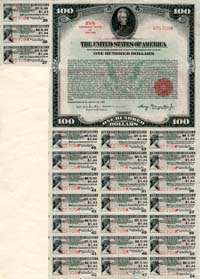
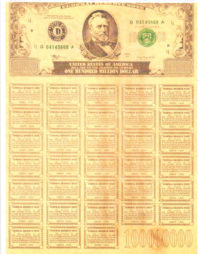
12 of the 13 cases in the Mother Box contained the Series 1934 Bonds. The difference between a genuine US Bond and the Bogus is striking just in a fraction of a glance. The layout is different, the legends are different, even the signatures have differences. Both contain the printed signature of Secretary of the Treasury, however the genuine bonds’ other signature is that of the Registrar of The Treasury, while on the Bogus Bond is that of the Treasurer of the United States of America. There is some fun in the language too. For a real bond you get One Hundred Dollars; with the Bogus Bond you get One Hundred Million Dollar – it lost its “s” and so will you if you play with these.
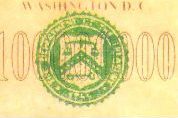
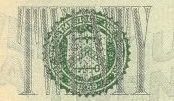
Furthermore, the printing on these is sloppy. Several of the printing experts, including one who has a conviction for counterfeiting, said they were shameful attempts at counterfeiting a bond not worthy of a journeyman press operator. For example, they were unable to even get the treasury seal on the dollar with a clear and crisp image. One just needs to look at the points of the seal to see that the Bad Green Seal has gaps in it as well as missing or points that lack – err points. The Good Green Seal has a crisp image with clear and defined points. “Even an idiot counterfeiter can make bills with good points if they use a decent offset printing press.” said one of the experts in printing that was consulted. The bonds fail on the printing style, quality and layout.
Paper size of the Bogus Bonds is 8×11 or just a hair smaller than an 8.5 x 11 sheet is US paper. All stocks and bonds I have even seen are printed on oversized paper to avoid the very real problem of copiers making counterfeit copies. Bogus Bonds fail on paper size.
Lastly, real bonds are printed from engraved plates, these, as supported by the previous discrepancies, seem to have been printed on a bad offset press.
Redeemable in Gold
The 1934 Note was a Federal Reserve Notes (currency) were issued in denominations of $5, $10, $20, $50, $100, $500, $1,000, $5,000 and $10,000 denominations. Specifically these notes were issued to replace the Federal Reserve Notes issued in 1914, 1918 and 1928 that contained the legend “Redeemable in gold on demand at the United States Treasury, or in gold or lawful money at any Federal Reserve Bank”. It seems the laws were changed in 1933 and the notes of the 1934 series needed to reflect the law change. And they did: the Emergency Banking Act of 1933 removed the gold obligation and authorized the Treasury to satisfy these redemption demands with current notes of equal face value (effectively making change). Thus the bonds, even if authentic, or even currency issues in 1914, 1918 or 1928 could be redeemed for gold in 1934. Further, as these were supposedly issued in 1934, the Federal Reserve and the US Treasury would have known this and not printed anything to suggest the possibility of a gold redemption on the bond.
There are other types of notes that are legal tender in the US such as US Notes and Federal Reserve Bank Notes, Silver Certificates, Gold Certificates and National Bank Notes – but that aspect of the history of banking and currency in the United States is for someone else to expand upon.
The contents of the 13th case had the safekeeping and travel certificates.
It is almost funny that a Treasury Certificate claiming that $25,000,000 Bond Issued by the United States of American has been deposited in the Treasury of The Federal Reserve is not signed by anyone at the Federal Reserve. Rather it is countersigned by the Treasurer of the United States and the Secretary of The Treasury of the United States – but not countersigned even as a counterfeit signature by anyone with the Federal Reserve System or any of the Federal Reserve Banks.
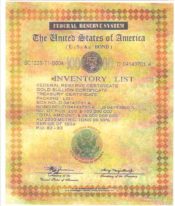
I really do not have much to say about the Inventory List as each line of it contradicts history, law, the separations of the Federal Reserve and the US Treasury and the fact that the gold is not on deposit with anyone.
Treaty of Versailles Scroll contained in a machined bit of pipe – since I have not seen a full image I cannot comment on the fullness of its comments, but I can say the into appears to be a miseducational rant on the history and origin of the bonds, why they are real, and perhaps some instructions for redemption.
Fonts
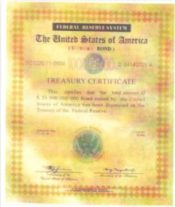
A font is the style of the letters and number and characters that compose a typeface. Guttenberg designed the first font for his printing press and as the printed word was popularized so were new font styles. Fonts continue to be born and evolve to this day. The fonts used on the bonds, the certificates, the treaty scroll and the mother box chests all did not exist in 1934, and in fact many were not created until the early 1970’s.
General Comments
The alternative media has been all abuzz about these bonds for years and they are fully stupid as any victim might be or they are part of the con. One quote from an ill education dupe or snake oil promoter was “In order to counterfeit these bonds it would be the kind of technology you would expect only a government to have.” This is
incorrect, as I have seen the counterfeits that other governments have produced of US Currency and secure documents, and the counterfeits are extremely well-executed. These bonds, notes and documents are not even counterfeits. To be a counterfeit you must copy faithfully the original documents or items. Such bonds or notes as these have never existed – they are full out fakes and frauds designed to dupe inexperienced and greedy conspiracy theorists. It also seems to work on dim reporters in the alternative media world.
The best guess efforts of the US authorities who report dealing with over 50 Mother Boxes per year is that they come from a remote printing and chest factory on the island of Mindanao. An island with 25 million people who speak 7 or more languages and fall into at least as many ethic groups. A location that has been in a state of flux since – well since well before World War I. In short, it is one of the most excellent areas to carry on this sort of mischief and attract little or no attention.
These boxes, however, have been a profitable venture for whomever has created them. The collection of experts agree that with an investment of about $6,200.00 and a bit of time these boxes and documents can be duplicated with period chests, period locks, all outfitted with 13 metal boxes filled with fake bonds. All of it properly antiqued using a collection of chemicals and aging processes known to art and antique furniture forgers world over. The experts speculated that if the work was to be done in China or Vietnam or India and several fully stocked Mother Boxes were to be ordered, one could reduce the cost of each chest to around $3,100. It appears they are already being made in the Philippines. The chests have been used to dupe lenders to lending but a fraction of the value of the underlying securities. Even if only 1% of the face value of the bonds is sought, it’s a big fraud. The borrower has always quickly vanished when they get their money, though they typically won’t disappear without a bit more fiscal theatre. They wish to make sure you do not go looking for them.
For example, the borrower calls the lender in a panic in that he must return the chest as the international cabal of manhunters (The Federal Reserve, Bank of International Settlements, Masons, Knights Templar, Kuomintang and let’s not forget the CIA) have found out where he, the borrower, is and that they demand the chest be returned. The best finale so far related to me is where the borrower in on the phone to the lender panicked and pleading for the chest to be retuned, when the lender hears on the other end of the phone call a bunch of screams and a loud noise, no doubt a gunshot. The borrower grunts and gasps and drops the phone and a new deep menacing voice asks the lender “Who is this and where is the chest?” Excellent drama to keep the lender from making any further inquiry.
I am aware of this scheme netting as little as $100,000 and as much as $2,750,000. It is some of the best fiscal theatre all aided and abetted by the idiot fringe on the web.
The intent of this article is twofold: to pen an authoritative investigation narrative on these bogus bonds, and to make a point that good investigations and real due diligence is a team effort. I have leaned on experts in:
• Locks, in particular period push key padlocks
• Dealers in vintage trunks and footlockers
• Several printers including some who were good at counterfeiting.
• A retired Treasury agent who laughed so hard she almost had an accident reading stories on the bogus bonds.
• My own knowledge of the history of currency, US Financial Systems and 20 plus years of looking into frauds including several cases of 1934 Series Treaty Of Versailles Bonds.
It takes a team with many different life experiences and backgrounds to really pull apart any investigation. No one investigator can ever do it all.
Photos have come from clients and blog / news posts on the web, ebay, Zero Hedge, LaBarre Galleries, Silver Doctors, the dubious IFR Investment Group

